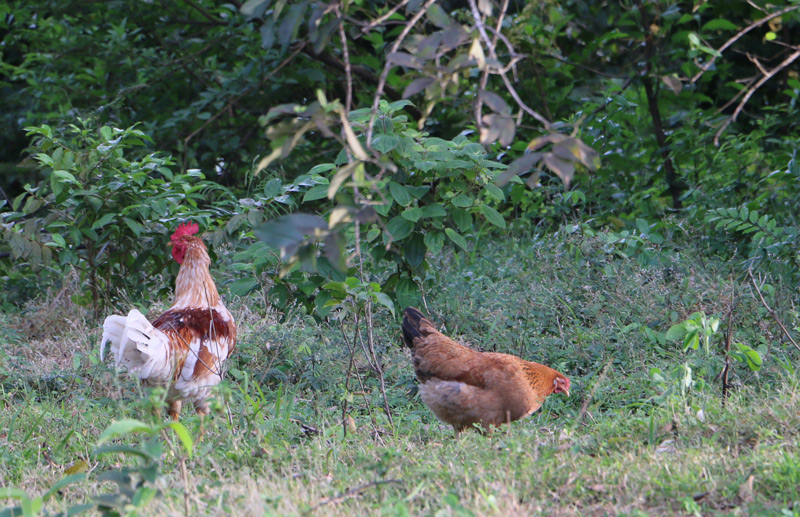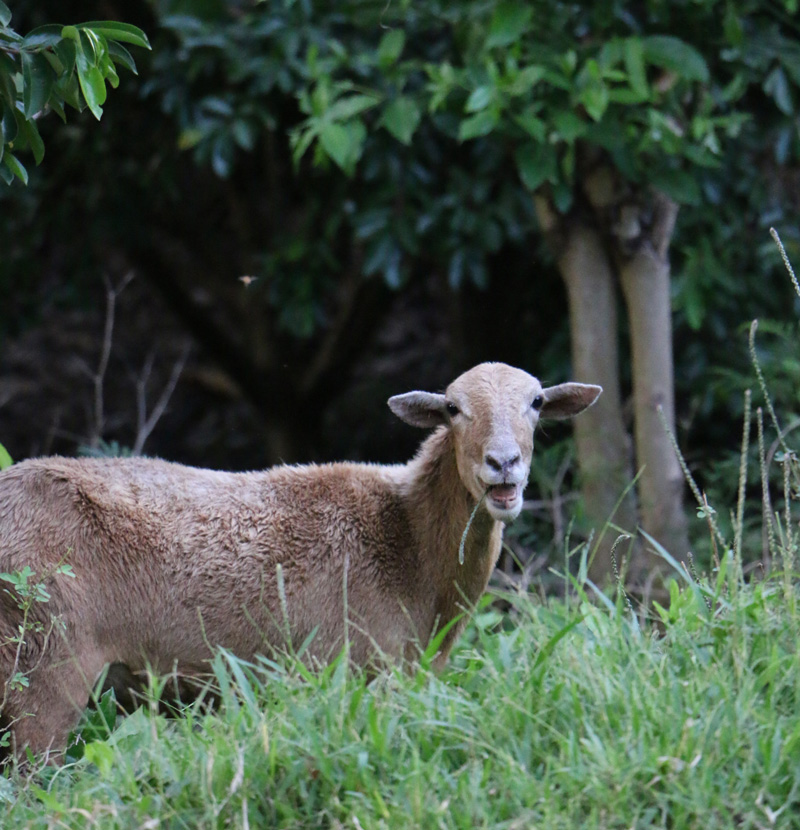The following is an excerpt from the upcoming 2nd edition of Create Your Own Florida Food Forest.
Oceans of ink have been spilled on the value of incorporating animal life on the homestead, with great ideas on “mob grazing” and chicken tractors and cut-and-carry systems for goats, as well as the value of bees and guinea fowl, ducks and even worm farming. These are all good things if you love taking care of livestock, but if you’re more of a low-maintenance gardener, you don’t have to feel bad about skipping domesticated animals altogether. God will provide many useful species for your food forest and they won’t require feeding, watering or de-worming. As in many things, there must be a balance.
Chickens
I have put chickens to work in my food forest and vegetable gardens. Yet chickens are also high maintenance and almost always require supplementary feed unless you make careful (and extensive) plans to feed them completely off your land. Over the years my view on chickens has changed. At first, I viewed them as essential to a small homestead. This was years ago when I had stars in my eyes about home-raised eggs and meat, with chickens free-ranging around a farmyard and kids carrying fluffy hens about. We learned later that chickens aren’t quite as perfect as they appear in magazine articles. Free range birds decorate your porch with droppings and tear up anything you mulch or plant. They also get eaten by predators, often in gruesome and terrifying ways. As I looked at the cost of feed and housing and my monthly budget, I grew less and less enamored with my flock and ended up selling it. Later, we tried again in the tropics but our half-wild yard fowl had a propensity to run away and not return. When I got back to the states in 2020, I resisted the idea of getting chickens again, until I saw empty shelves in the local grocery store and realized that the supply line really might shut down at some point. I was also pushed to get chickens by my friend Carolyn Smith, who sent me multiple superchats on YouTube for a “chicken fund.” Eventually I gave in at the beginning of 2021 and am glad I did. We are raising them with much more success here in the Alabama countryside than we had in our previous locations. Part of this is due to having more land and resources and the other part of it is due to our past experiences informing our current methods. The issue of getting enough chicken food still exists, but we are trying various experiments again to see if we can balance buying food and free ranging with tractors and home-raised grains. There is a good argument to be made that the cost of chickens and their eggs should be less of a consideration compared to the superior quality and nutrition afforded by home-raised eggs and meat. Incorporating them is a worthy endeavor, if possible, but may not be for those with limited time or severe budget constraints. There is also a learning curve, and keeping animals – even just a few hens – does tie you down much more than does a food forest.

Over the years we experimented with goats, rabbits, ducks, guinea fowl and velociraptors. Most of them were more trouble than they were worth to us in yields. Especially when the velociraptors figured out how to get into the emergency ice cream stockpile in the chest freezer.
Pets
In an urban environment, domesticated animals are even harder to keep in a food forest – and some pets that are often added to yards, such as dogs and cats, can be destructive in a food forest system. Dogs will dig and trample and sometimes even eat your plants. Cats happily murder birds, lizards and other beneficial species. If you keep pets, it’s important to make sure they don’t damage all your hard work or make it impossible to get a system going. I knew a man in North Florida who told me he couldn’t grow gardens in his backyard because his two huge dogs destroyed everything.
Ouch.
Instead of having a garden that could feed his family, he had to feed two large animals that also kept him from growing food. Gardens are generally assets, whereas pets, even adorable little Poofykins, may be liabilities.
f you have pets, figuring out how to keep them from wrecking your hard work should be at the top of your priority list. When your food forest system grows in maturity, the pets won’t be as big an issue. Dogs and cats may even become assets as they chase away deer and squirrels. I certainly understand the value of animal companionship – just don’t let your pets keep you from growing food. It’s worth figuring out how to balance both pets and gardens.


2 comments
Great ideas. You can also use fencing to keep the critters out of certain areas of the garden, such as where the foliage and fruits are too delicate to have animals walking around.
I feel like there’s such a range of practicality for pets. At one end of the spectrum you have the insane dogs that run loose and dig up your gardens, kill your chickens (or your neighbors!), and also bark up a storm and annoy everyone. And at the other end you have the well-trained sheepdog that keeps predators away from your chickens more effectively than any fencing system. Although with dogs at least, I have long suspected that the main difference between those extremes lies in the pet owner.
We got so lucky with our cat. He kills every small rodent on the property; we’ve got grain for the chickens all over the place yet we’ve never had a rodent problem. And he also seems to have a keen ability to distinguish between livestock and pests; while he’s occasionally chased flying squirrels, snakes, turkeys, skunks, and various other wildlife (with mixed success), he’s never once gone after even our free-ranging chicks. Perfect farm cat.
Comments are closed.